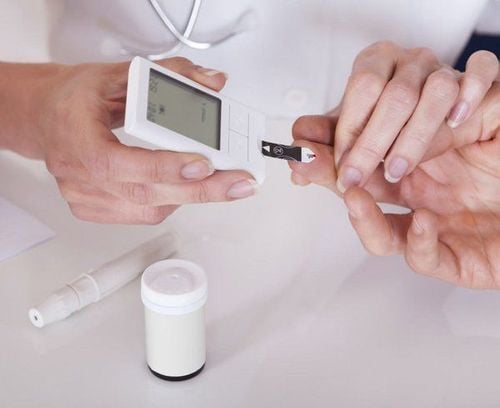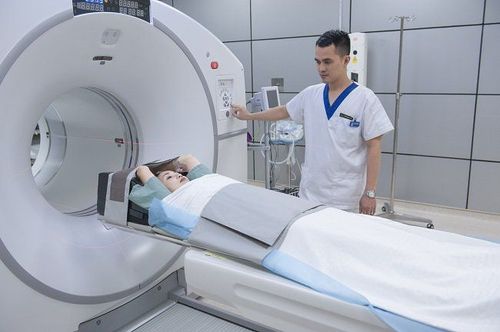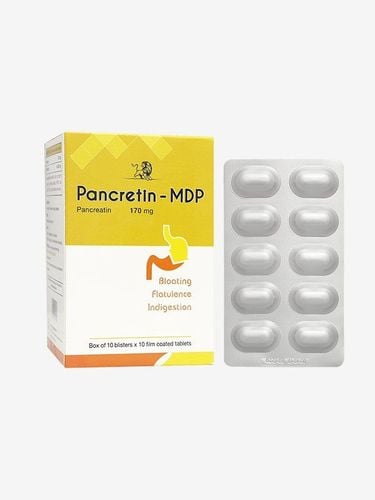This is an automatically translated article.
The article was written by Master - Doctor Mai Vien Phuong - Head of Department of Gastrointestinal Endoscopy - Department of Medical Examination & Internal Medicine - Vinmec Central Park International General HospitalIdentification of pancreatic cancer markers is essential for cost-effective and outcome-consistent screening. Post-pancreatitis diabetes and fat deposition in the pancreas should be diagnosed early for this purpose.
1. Pancreatic cancer and tests for early diagnosis
The incidence of pancreatic cancer has been increasing since the 1990s. It is estimated that about 90% of pancreatic cancers are unresectable at the time of diagnosis. Therefore, early detection of pancreatic cancer is very important to reduce the burden of this disease. Developing an accurate test for the early detection of sporadic pancreatic cancer will significantly improve survival of patients.Identifying the markers of individual pancreatic cancer and developing screening methods based on them is another avenue to reduce the burden of this disease. New-onset diabetes and obesity are recognized as among the most prominent risk factors for pancreatic cancer.

2. Persistent hyperglycemia and the risk of pancreatic cancer
A 2011 meta-analysis of 35 cohort studies found that people with common diabetes had a 1.9 times higher risk of pancreatic cancer than those without diabetes. Fasting blood glucose profiles over a 60-minute period were constructed for patients diagnosed with pancreatic cancer (as well as matched controls). The authors showed that the first rise in blood sugar occurred 30 to 36 months before the diagnosis of pancreatic cancer and reached the diabetic threshold 6 to 12 months before the cancer diagnosis.Fasting blood glucose levels increase with tumor volume:
Furthermore, fasting blood glucose levels increase with tumor volume, with the smallest tumor volume associated with hyperglycemia being 1.1 - 2 0.0 mL (significantly smaller than the mean tumor volume of 11.5 mL at diagnosis of pancreatic cancer). In theory, diagnosing pancreatic cancer when the tumor is small could significantly increase cure rates and long-term survival.
However, in practice, hyperglycemia alone cannot be implemented as a cost-effective screening strategy because pancreatic cancer is rare, while hyperglycemia is very common. Furthermore, hyperglycemia in the setting of pancreatic cancer represents a paraneoplastic syndrome and is, therefore, nonspecific.
For example, data from 2 large prospective cohorts (494,078 people) in the United States published in 2020 confirmed that incident diabetes is a significant risk factor for cancer. pancreas. However, the study also found that diabetes was a significant risk factor for cancer in seven other organs (breast, large intestine, visceral, esophagus, liver, lung, and thyroid). Combining diabetes with weight loss was shown to increase the likelihood of predicting the occurrence of pancreatic cancer in a 2018 retrospective study, however, weight loss is another nonspecific symptom and therefore, is not likely to be much more useful in determining the risk of pancreatic cancer (compared to cancers in the 7 organs mentioned above).
Trắc nghiệm: Bạn biết gì về các yếu tố nguy cơ, chẩn đoán và điều trị ung thư tuyến tụy?
Ung thư tuyến tụy phổ biến thứ 10 trong những bệnh ung thư mới và là nguyên nhân thứ 4 gây tử vong do ung thư ở nam, nữ. Bài trắc nghiệm này sẽ kiểm tra kiến thức của bạn về các yếu tố nguy cơ, chẩn đoán và cách điều trị ung thư tuyến tụy.
Bài viết tham khảo nguồn: medicalnewstoday 2019
3. Accurately identify pancreatic cancer risk in people with persistent hyperglycemia
Conceivably, an accurate determination of pancreatic cancer risk in individuals with persistent hyperglycemia can only be achieved when factors specifically related to the pancreas are considered. One such factor is inflammation of the pancreas before the onset of diabetes. New-onset diabetes is a subtype of diabetes in the exocrine pancreas and is caused by acute pancreatitis in 4 out of 5 people and chronic pancreatitis in 1 in 5.A large 2020 cohort study by Cho et al compared the risk of developing pancreatic cancer in new-onset diabetes with type 2 diabetes without a history of pancreatitis and found, New-onset diabetes is associated with a seven-fold higher risk of pancreatic cancer. This was true after adjusting for age, sex, ethnicity, social deprivation index, alcohol abuse, smoking, history of gallstones, cholecystectomy and the Charlson comorbidities index. When given a 12-month delay between the diagnosis of diabetes and the diagnosis of pancreatic cancer (to minimize the possibility of an inverse causality), the results did not change significantly.

4. People with a history of pancreatitis (without diabetes) have a higher risk of pancreatic cancer than people with type 2 diabetes without a history of pancreatitis
People with a history of pancreatitis (without diabetes) had a significantly higher risk of pancreatic cancer 4.8 times compared with people with type 2 diabetes without a history of pancreatitis. This suggests that diabetes without a history of pancreatitis is not a major risk factor for pancreatic cancer; rather pancreatitis is a major risk factor for pancreatic cancer in people with diabetes. What's more, research shows that an attack of pancreatitis in people with diabetes has a different effect on later pancreatic cancer risk, depending on whether it occurs before or after diabetes. Street.Specifically, the study found that people with new-onset diabetes had a significantly 2.3 times higher risk of pancreatic cancer than those with type 2 diabetes prior to inflammation. pancreas. This suggests that the increased risk of pancreatic cancer in people with new-onset type 2 diabetes is not solely due to the effects of pancreatitis as a comorbidity.
5. People with diabetes have a high risk of pancreatic cancer
The 2018 Mayo Clinic study and the 2020 COSMOS study are complete in nature, paving the way for the identification of populations at high risk for pancreatic cancer in a cohort of individuals with diabetes. Street. The 3-year incidence of pancreatic cancer in the Mayo Clinic study was 1.0% in individuals with diabetes, consistent with the estimate of 0.7% in those with diabetes in the overall population. COSMOS research group. The Mayo Clinic developed a model using data from 1516 individuals first diagnosed with diabetes (based on estimated fasting blood glucose and/or mean glucose) and pancreatic cancer incidence. increased to 3.6% after applying the model. The model required 5 variables: Age at first diagnosis of diabetes, blood glucose levels at two time points (approximately 12 months before and at first diagnosis of diabetes), and weight at two time points. score (about 12 months before and at the first diagnosis of diabetes).6. Resected pancreatic cancer carries the highest risk in people with new-onset diabetes
The COMSOS study of 139,843 people offered a unique complementary approach that considered a history of pancreatitis prior to the initial diagnosis of diabetes (regardless of changes in blood glucose and weight prior to the onset of diabetes). have diabetes). This study found that resected pancreatic cancer conferred the highest risk (hazard ratio 16.2) in people with new-onset diabetes. This may reflect the ability to detect pancreatic cancer at an earlier stage in people with new-onset diabetes than with type 2 diabetes. This may be because people have the disease. New-onset diabetes is more likely to require more work during hospitalization for pancreatitis (eg, with earlier abdominal imaging) and to be monitored more closely after discharge.
7. Attention should be paid to the history of pancreatitis in people with diabetes for pancreatic cancer
Based on the above findings, it can be suggested that taking into account a history of pancreatitis (in addition to age at diagnosis of diabetes, changes in blood glucose and body composition prior to diabetes) would increase the ability to screen people with diabetes for possible pancreatic cancer. Purposely designed studies are guaranteed to operate the combined method. Essentially, however, it can be applied to all middle-aged and older adults after acute pancreatitis, who develop new-onset diabetes and unintentional changes in body composition. possible during follow-up. This could ultimately make screening for pancreatic cancer cost-effective and consistent with results.Currently, Vinmec International General Hospital has been implementing cancer screening packages. At Vinmec, there are a full range of modern diagnostic facilities such as: PET/CT, SPECT/CT, MRI, myelogram blood test, histopathology, immunohistochemistry test, gene test, stool biology test death, as well as a full range of targeted drugs, the most advanced immunotherapy drugs in cancer treatment. Multimodal cancer treatment from surgery, radiation therapy, chemotherapy, hematopoietic stem cell transplantation, targeted therapy, immunotherapy in cancer treatment, new treatments such as autoimmunotherapy body, heat therapy,...
After having an accurate diagnosis of the disease and stage, the patient will be consulted to choose the most appropriate and effective treatment methods. The treatment process is always closely coordinated with many specialties: Diagnostic Imaging, Biochemistry, Immunology, Cardiology, Stem Cell and Gene Technology; Department of Obstetrics and Gynecology, Department of Endocrinology, Department of Rehabilitation, Department of Psychology, Department of Nutrition, ... to bring the highest efficiency and comfort to the patient. After undergoing the treatment phase, the patient will also be monitored and re-examined to determine whether the cancer treatment is effective or not.
Thanks to modern facilities, a team of qualified doctors, perfect medical services, have brought confidence, health and good quality of life to patients who come to visit and treat diseases at the hospital. Vinmec.
Please dial HOTLINE for more information or register for an appointment HERE. Download MyVinmec app to make appointments faster and to manage your bookings easily.













